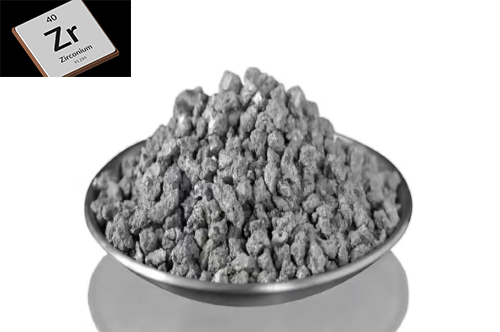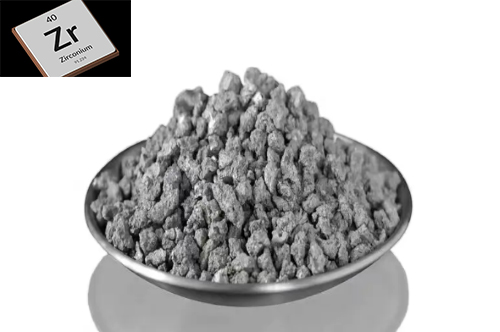Zirconium Sponge: A Strategic Material

Zirconium sponge is a highly pure, porous metallic zirconium product. It is critical to industries ranging from nuclear power to aerospace for its corrosion resistance, strength, and low neutron absorption.

Production of Zirconium Sponge
The production of zirconium sponge begins with naturally occurring silicate zircon (ZrSiO₄), which is found in heavy mineral sands. The most widely used industrial process for the production of zirconium metal from zircon is the Kroll Process, a high-temperature, batch process that has been the norm since the 1940s.
- The first process is to transform zircon into zirconium tetrachloride (ZrCl₄) through a chlorination reaction.
- The volatile material is then purified through sublimation to remove impurities, particularly significantly hafnium—a chemically similar element that must be removed for nuclear-grade application due to high neutron absorption.
- During the process of reduction, purified ZrCl₄ is reduced using magnesium in an airtight vessel in an inert atmosphere (usually argon) at a temperature range of approximately 800–1000°C.
- The chemical reaction results in zirconium sponge and magnesium chloride as a by-product.
- When it cools down, the sponge is leached and washed to remove any leftover salts and non-reacted magnesium, and thus a light-weight, porous metal mass is formed.
Properties and Benefits
Zirconium sponge is highly valued because
- High purity: Especially in nuclear-grade forms.
- Good corrosion resistance: Particularly in acids and in seawater.
- High melting point: 1855°C, suitable for severe environments.
- Low neutron absorption: A key property for nuclear reactors.
- Non-magnetic and biocompatible: Suitable for use in electronics as well as in medical applications.
Classification of Zirconium Sponges
Two general grades of zirconium sponge are supplied:
- Nuclear Grade: It is this very pure grade which contains very small amounts of hafnium (typically <100 ppm) and other minor impurities. Because of its low neutron-capture cross-section, it can be used in nuclear reactor fuel cladding and structural material applications.
- Commercial/Industrial Grade: It contains higher amounts of hafnium and is used in chemical processing, aerospace, and other non-nuclear applications.
Applications across Industries
1. Nuclear Industry
The most important use of zirconium sponge is in the nuclear energy sector. Once processed into ingots and alloyed into forms such as Zircaloy, zirconium becomes the primary material for fuel cladding in nuclear reactors. Fuel rods must contain the radioactive fuel safely and withstand intense neutron radiation, high heat, and corrosive conditions—all of which are handled beautifully by zirconium.
2. Aerospace and Defense
In the aerospace industry, zirconium is being used in special alloys that require strength, minimum weight, and corrosion resistance. It is also found in missile systems, and space exploration applications. Its application in rocket propulsion systems is enabled by its heat shock and temperature resistance.
3. Chemical Processing
Zirconium comes with excellent corrosion resistance, so it is precious for chemical and petrochemical equipment. Heat exchangers, reactors, and piping systems used to deal with extremely corrosive chemicals like hydrochloric acid or sulfuric acid frequently rely on zirconium-containing materials to prevent deterioration and extend service life.
4. Medical and Industrial Applications
Even applied more often in alloyed or pure forms for medical use, zirconium sponge is raw material for surgical instruments, implants, and biomedical coatings. Zirconium sponge is non-toxic and bioinert and can therefore be applied in contact with body tissues for extended periods.
Global Availability and Strategic Significance
Geographically concentrated production and strategically positioned possession of zirconium sponge result from its critical applications. Major producers are:
- China: Largest capacity with increased presence in industrial and nuclear markets.
- Russia: Traditional supplier, specifically nuclear-grade sponge through companies like TVEL.
- United States and Europe: Western manufacturers like Advanced Refractory Metals (ARM) provide commercial and nuclear industries.
Hafnium removal from zirconium is technically difficult and costly, making nuclear-grade sponge production complicated. It is typically done by solvent extraction or fractional distillation, and the availability of hafnium-free zirconium sponge is a reactor design and fuel cycle planning limitation.
Challenges and Future
While zirconium sponge remains essential, its manufacture poses several challenges:
- Environmental impact: The Kroll process is energy-intensive and wasteful.
- Supply chain security: Geopolitical risks and limited sources have the potential to affect availability.
- Material recycling: Recycling programs are being pursued to reclaim zirconium from spent fuel and industrial scrap to reduce dependence on primary production.
Demand for zirconium sponge will rise in the future with increasing nuclear power, including progress in small modular reactors, as well as technological improvements in aerospace and high-performance materials.
Conclusion
Zirconium sponge may not be well known, but it is the basis for several next-generation technologies. With the world's focus, zirconium sponge will be a strategic facilitator for tomorrow's technologies.
{{item.content}}
LEVE A REPLY
{{item.children[0].content}}
{{item.content}}






